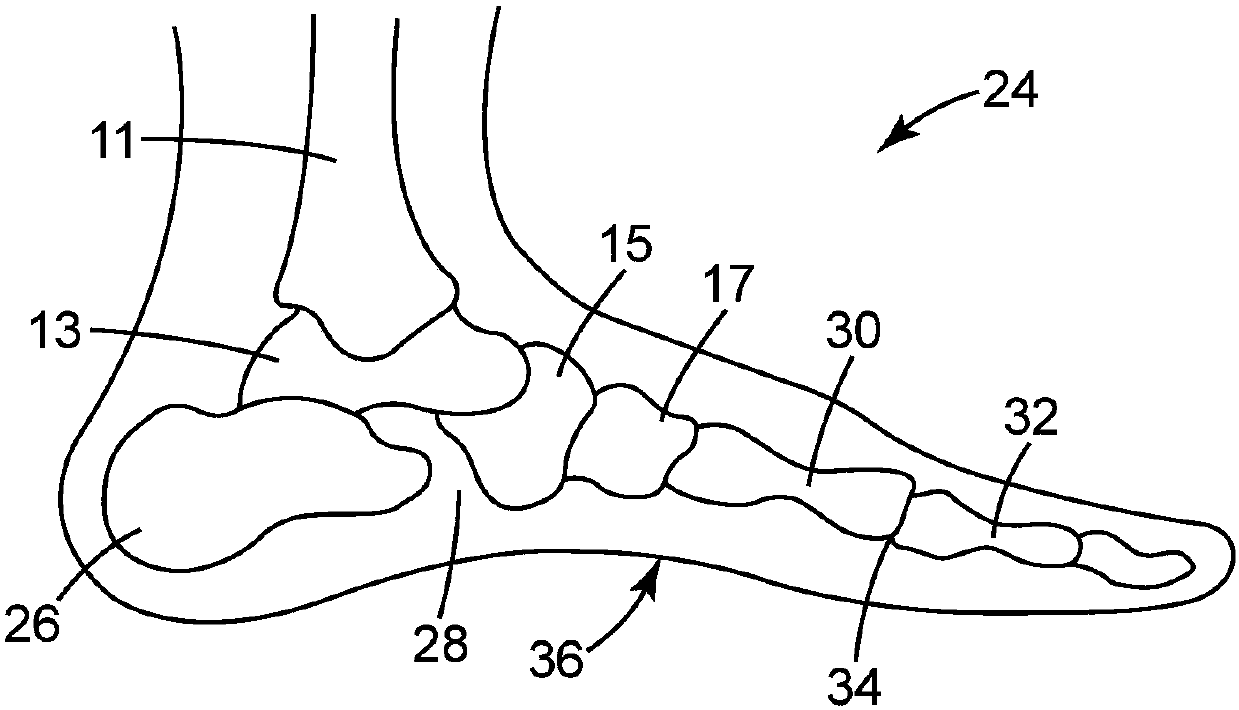Plantar Fascia Support System
A technology of fascia and foot pads, applied in the field of plantar fascia support system, can solve the problems of not allowing users to walk around, night splints not allowing sufficient range of motion, flexion or stretching, etc., to increase the possibility of repeated use , reduce pain or discomfort, and increase compliance
- Summary
- Abstract
- Description
- Claims
- Application Information
AI Technical Summary
Problems solved by technology
Method used
Image
Examples
Embodiment
[0069] 1. An assembly for supporting the plantar fascia of a wearer, said assembly comprising:
[0070] a footplate contoured to conform to the arch area of the wearer's foot, the footplate including a contoured shape including a medial arch and a lateral arch;
[0071] An adjustable strap adapted to maintain the footrest plate proximal to the arch area during use, wherein the assembly is bipedal.
[0072] 2. The assembly of embodiment 1, wherein the footplate comprises a heat-extensible material.
[0073] 3. The assembly of embodiment 1, wherein the footplate comprises a shape memory material.
[0074]4. The assembly of any one of the preceding embodiments, wherein the footbed has a continuous thickness of at least 0.04 inches and no greater than 0.06 inches.
[0075] 5. The assembly of any one of the preceding embodiments, wherein the adjustable strap includes a dimple, and wherein the footrest remains in the dimple during use.
[0076] 6. The assembly according to any ...
example
[0093] testing method
[0094] Flexure resistance
[0095] This test provides a means of determining the force (pound-force (lbf)) required to displace a formed footplate a specified distance (in inches).
[0096] Place the sample foot plate on the TCD225 Series Digital Force Testers (available from Ametek Corporation, Largo, Florida). Apply force in a direction generally normal to the center of the sample foot plate. The force required to displace the sample over a distance interval is recorded.
[0097] Sample Preparation
[0098] Sample footplates were produced by injection molding the specific materials listed in Table I (below) in a mold to provide figure 2 The outline shown. Each footplate has a continuous thickness of about 0.04 inches. Three samples of each example footbed construction (F1, F2, F3, F4, F5) were tested according to the method above.
[0099] Table I
[0100]
[0101] Globalene HP600s is a polypropylene homopolymer purchased from Le...
PUM
 Login to View More
Login to View More Abstract
Description
Claims
Application Information
 Login to View More
Login to View More - R&D Engineer
- R&D Manager
- IP Professional
- Industry Leading Data Capabilities
- Powerful AI technology
- Patent DNA Extraction
Browse by: Latest US Patents, China's latest patents, Technical Efficacy Thesaurus, Application Domain, Technology Topic, Popular Technical Reports.
© 2024 PatSnap. All rights reserved.Legal|Privacy policy|Modern Slavery Act Transparency Statement|Sitemap|About US| Contact US: help@patsnap.com










